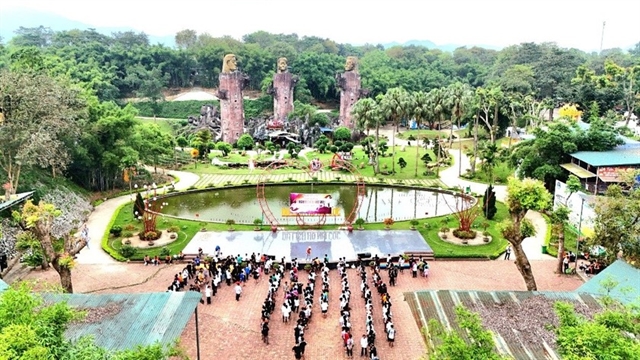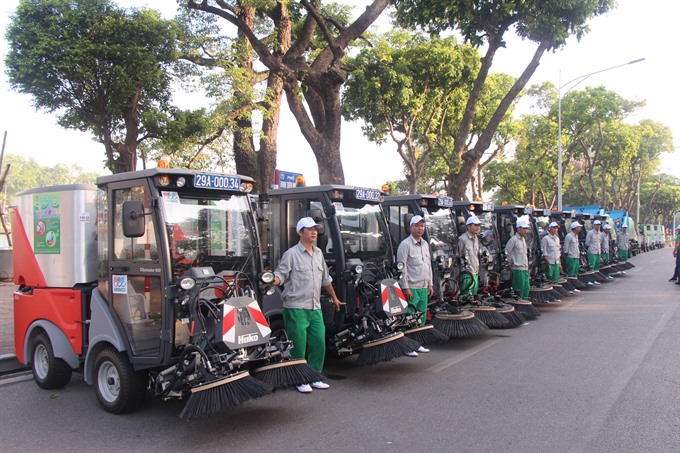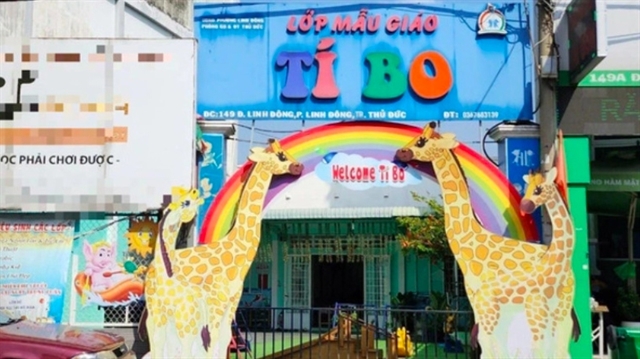.jpg) Society
Society

Urbanisation and a sharp increase in population have presented a number of challenges for Hà Nội, one of which is the collection and treatment of household waste in a way causes minimal impact to the environment.
 |
| Workers of the Hà Nội Urban Environment One Member Co Ltd stand by City Master trucks which will be used to collect gabbage in the capital city. — VNA/VNS Photo Mạnh Khánh |
HÀ NỘI — Urbanisation and a sharp increase in population have presented a number of challenges for Hà Nội, one of which is the collection and treatment of household waste in a way that causes minimal impact to the environment.
Hà Nội discharges nearly 5,400 tonnes of household garbage per day, of which 3,200 tonnes come from urban areas, and the remaining waste from rural areas, according to the municipal Department of Natural Resources and Environment.
However, only 70 per cent of the garbage was transported to treatment zones.
Last year, four main districts Ba Đình, Hoàn Kiếm, Hai Bà Trưng and Đống Đa used trucks to collect garbage. But in other districts, collections were still conducted with handcarts, which are less environmentally friendly and tend to exacerbate traffic congestion.
Nguyễn Xuân Tuân, who works as a motorbike taxi driver in Hai Bà Trưng District, said that water leaking from the garbage has a bad smell and attracts a large amount of flies.
Nguyễn Thị Xuân, another resident in Yên Hòa Ward, Cầu Giấy District, said that after the carts were emptied they were not covered or cleaned, thus causing an unpleasant odour for local residents.
A report in the Hà Nội Mới (New Hà Nội) newspaper showed that in suburban districts such as Phúc Thọ, Quốc Oai, Ba Vì and Chương Mỹ, daily collection and treatment of garbage was undertaken only in main towns, while remote communes saw collections only once every three days.
Nguyễn Hữu Tiến, director of the Hà Nội Urban Environment One Member Co Ltd (URENCO), told the newspaper that main districts of the capital city now lacked garbage collection stations, so garbage is gathered on the street before being taken to garbage treatment zones, causing environmental pollution.
The garbage collection stations had not been built because districts could not arrange proper land for them, said Tiến.
Besides, some residents often left their rubbish on streets and in public places, making collection difficult, he said.
Recently, the Hà Nội People’s Committee asked URENCO to use trucks to collect and transport household waste in main districts, and complete procedures to set up a garbage collection station in Bồ Đề Ward, Long Biên District.
The municipal People’s Committee also asked the Hà Nội Department of Planning and Investment to call on investment to build another garbage collecting station of about 1.5ha, in Tây Mỗ Ward, Nam Từ Liêm District.
Other districts were requested to conduct surveys and research to find suitable places to set up garbage collection stations and then report back to the municipal People’s Committee. — VNS




.jpg)




.jpg)